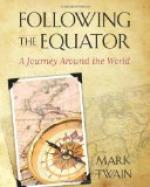“The wind, which had been blowing all the morning from the N.E., increased to a heavy gale, and I shall never forget its withering effect. I sought shelter behind a large gum-tree, but the blasts of heat were so terrific that I wondered the very grass did not take fire. This really was nothing ideal: everything both animate and inanimate gave way before it; the horses stood with their backs to the wind and their noses to the ground, without the muscular strength to raise their heads; the birds were mute, and the leaves of the trees under which we were sitting fell like a snow shower around us. At noon I took a thermometer graded to 127 deg., out of my box, and observed that the mercury was up to 125. Thinking that it had been unduly influenced, I put it in the fork of a tree close to me, sheltered alike from the wind and the sun. I went to examine it about an hour afterwards, when I found the mercury had risen to the-top of the instrument and had burst the bulb, a circumstance that I believe no traveler has ever before had to record. I cannot find language to convey to the reader’s mind an idea of the intense and oppressive nature of the heat that prevailed.”
That hot wind sweeps over Sydney sometimes, and brings with it what is called a “dust-storm.” It is said that most Australian towns are acquainted with the dust-storm. I think I know what it is like, for the following description by Mr. Gape tallies very well with the alkali duststorm of Nevada, if you leave out the “shovel” part. Still the shovel part is a pretty important part, and seems to indicate that my Nevada storm is but a poor thing, after all.
“As we proceeded the altitude became less, and the heat proportionately greater until we reached Dubbo, which is only 600 feet above sea-level. It is a pretty town, built on an extensive plain . . . . After the effects of a shower of rain have passed away the surface of the ground crumbles into a thick layer of dust, and occasionally, when the wind is in a particular quarter, it is lifted bodily from the ground in one long opaque cloud. In the midst of such a storm nothing can be seen a few yards ahead, and the unlucky person who happens to be out at the time is compelled to seek the nearest retreat at hand. When the thrifty housewife sees in the distance the dark column advancing in a steady whirl towards her house, she closes the doors and windows with all expedition. A drawing-room, the window of which has been carelessly left open during a dust-storm, is indeed an extraordinary sight. A lady who has resided in Dubbo for some years says that the dust lies so thick on the carpet that it is necessary to use a shovel to remove it.”
And probably a wagon. I was mistaken; I have not seen a proper duststorm. To my mind the exterior aspects and character of Australia are fascinating things to look at and think about, they are so strange, so weird, so new, so uncommonplace, such a startling




